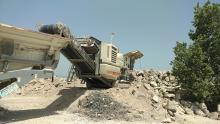Much of the research to date to reduce the environmental impacts of concrete has focused on the partial replacement of cement with industrial by-products, such as fly ash, ground granulated blast furnace slag, and silica fume.
In comparison, conservation of natural aggregates has been largely ignored in the United States even though these materials take about half of the concrete mix by volume. Recycling of old concrete in the form of aggregate has been mostly in non-structural applications such as sidewalks, bulk fills, erosion control, and roadway sub-base even though the quality of the recycled material is often significantly higher than is required in these applications.
Undeniably, recycling old concrete into material suitable for structural applications has some added costs for higher quality control, but the process is likely to be more cost-effective and more sustainable than mining, processing, and transporting new natural aggregates. Given the recent emphasis on improving our nation’s aging infrastructure, increases in the supply of recycled concrete and the demand for new concrete will be significant.
Despite the environmental and potential economic benefits of recycling concrete into new construction, only a small amount of recycled concrete aggregates has been used in structural engineering projects in the US.
The primary obstacles against their increased utilisation include the variability of recycled material properties and quality from different sources, limited fundamental research on the mechanical behaviour of recycled concrete aggregates concrete, limited research on the long-term behaviour of recycled concrete aggregates concrete, and no engineering guidelines or standards for the design and construction of reinforced concrete structures with significant levels of recycled concrete aggregates.
Aiming to address these issues, research in the Department of Civil and Environmental Engineering and Earth Sciences at the University of Notre Dame in Indiana has been experimentally and analytically demonstrating that recycled concrete aggregates is a viable substitution for natural aggregates in reinforced concrete building construction.
To gain knowledge of the fundamental material behaviour of recycled concrete aggregates concrete, researchers focused on characterizing the regional variability in the recycled concrete aggregates properties and quality, methods of replacing natural aggregates with recycled material, and the effects on hardened concrete behaviour.
It was observed that increased water absorption of recycled concrete aggregates and often significant amounts of deleterious materials left over from demolition (such as, brick, wood, asphalt, and glass) could be used as indicators to help predict the strength and stiffness of concrete made using a particular recycled concrete aggregates. Generally, recycled concrete aggregates concrete has reduced strength and stiffness with increased recycled concrete aggregates water absorption and deleterious material content, although this effect is much more significant on the concrete stiffness.
Provided that specified limits on the recycled concrete aggregates water absorption and deleterious material content are met, material from typical recycling plants in the United States can produce 100 percent replacement of natural aggregates in new concrete with compressive strength and stiffness adequate for structural applications.
“Because of the greater effect of RCA [recycled concrete aggregates] on concrete stiffness and the ability of RCA concrete to achieve similar strengths as natural concrete, the limiting factor for the increased use of recycled concrete could be how RCA concrete performs under day to day service loads and conditions over a long period of time during the service life of a structure,” said Adam Knaack, a design engineer with Schaefer in Cincinnati, Ohio, and project researcher.
To study this behaviour, 16 reinforced concrete beams were subjected to sustained loading for a period of at least four months while varying the amount of recycled concrete aggregates in addition to other parameters such as the service load level and the amount of reinforcing steel.
“As we suspected, increased amounts of recycled concrete aggregates resulted in significant increases in both the immediate and long-term deflections of reinforced concrete beams,” Knaack said, “but we’ve been able to develop models that can provide reasonable estimates for this short-term and long-term service load behaviour.” Subsequent testing of the beams to failure under ultimate loads demonstrated that current design and analysis methods for conventional reinforced concrete structures are applicable for recycled concrete aggregates concrete as well.
The results from this research help to provide guidance for quantifying the effects of recycled concrete aggregates on the mechanical and structural behaviour at service-level and ultimate limit states. According to Yahya Kurama, a professor of civil engineering at the University of Notre Dame and principal investigator of the research funded by the National Science Foundation, “these results could be used by engineers to design concrete structures that incorporate varying amounts of RCA [recycled concrete aggregates] for reduced environmental impact than concrete structures made with natural aggregates.”
The research can be found in a paper titled Sustained Service-Load Behaviour of Concrete Beams with Recycled Concrete Aggregates, accepted and soon to be published by ACI Structural Journal.






